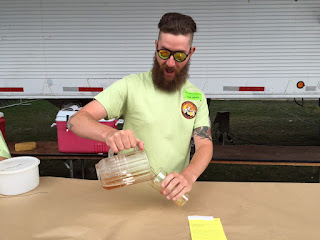 |
| Craig Hartinger offering a toast to Samuel Smith's last spring at the Craft Brewers Conference. |
Among the most important--and least heralded--heroes in the craft beer renaissance were importers. Americans were wholly ignorant of world brewing traditions back in the 1970s and '80s, and as breweries started making new, full-flavored beers, they had to educate consumers about the beers they were trying to sell them. American craft breweries have in the past decade developed their own vernacular, but at the outset, they were reproducing European styles. The best way to teach people about those styles was pointing them to the breweries who had already mastered them. Enter the importers.
They formed that knowledge bridge that was a critical precursor for the development of craft brewing. We started hearing words like "stout" and "doppelbock" and "abbey ale" and we wondered what these beers tasted like. It wasn't that we didn't trust our local breweries, it was that we wanted to go to the source first. Like tuning forks, those first imported beers we drank allowed us to set the pitch of our palates. Even today, we refer to classic styles by referencing the European breweries that make classic examples.
When I started writing The Beer Bible, I went to importers to act as liaisons to those breweries--and also to guide and educate me about the national traditions they represented. In my acknowledgements, I mentioned some of those folks, but not one of the most important: Craig Hartinger at Merchant du Vin. Craig stopped in at the Seattle book event, and the recognition of this failure crashed in on me. I can't believe I failed to mention him.
Merchant du Vin was one of the first importers to expose Americans to the very best of European brewing. Among the breweries they import are Ayinger, Orval, Rochefort, Samuel Smith, Traquair House, and Westmalle. Craig helped me arrange tours at Ayinger, Orval, and Rochefort--and most amazingly, the extremely reclusive Samuel Smith's. Over the past five years, I've regularly turned to him for information, advice, or a connection to one of his breweries, and he has always replied (usually within the hour) with good cheer and great information. Writing the Beer Bible was an exercise in asking for help, and there were a handful of people who made the book what it is. Without their help, it would have been a substantially diminished product. Craig Hartinger is one of those folks.
Importers don't get the appreciation they deserve, and I hate that I have compounded this oversight by neglecting to mention Craig and Merchant du Vin. So until the second edition comes out, let me say it here: thanks, Craig.
Postscript. The success of local brewing has not been great for importers. Why bother with an English IPA when you can get 213 of them right here at home? Or even a doppelbock or abbey tripel? The reason, of course, is because they taste different. The United States has developed its own palate, and now when we make versions of these beers, they're further and further distant from their inspirations. It's a wonderful surprise to revisit some of these grand old beers. So do yourself a favor and go pick up an Ayinger Celebrator, Orval, Rochefort 10, Samuel Smith's India Ale, and Traquair House Ale. You will thank yourself.




















